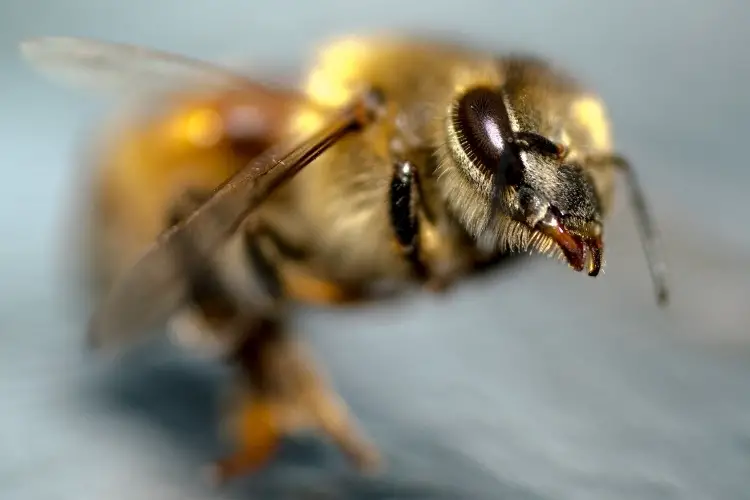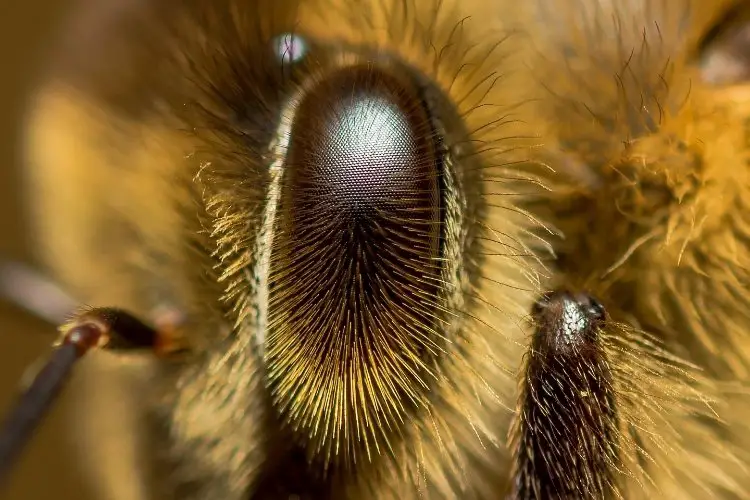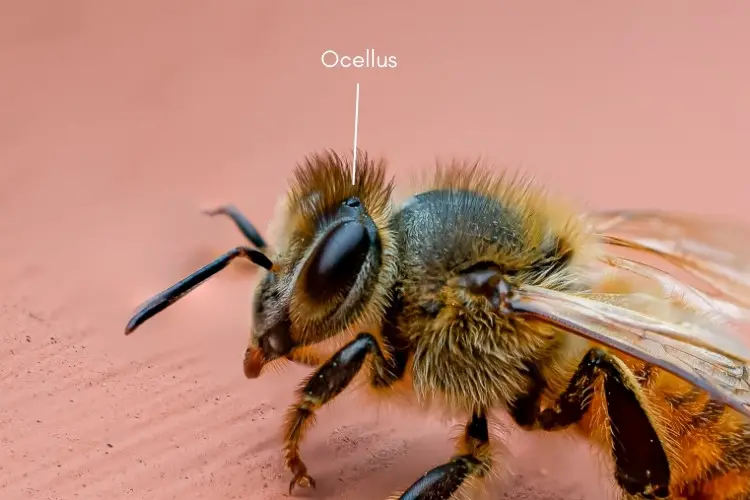Honey bees have 5 eyes. Two of these eyes are called compound eyes, which are located on either side of a bee’s head. These compound eyes are large and easy to spot. The other 3 eyes, called ocelli, are found on top of the bee’s head, above the compound eyes. They are smaller and less visible.

Why Do Bees Have 5 Eyes?
The 5 eyes of a bee can be divided into 2 groups, ocelli, and compound eyes.
The compound eyes are more prominent and form a large part of the front of a bee’s face.
The other 3 are called ocelli, or simple eyes, and are located on the top of a bee’s head. Ocelli are much smaller than the compound eyes and harder to spot.
Both sets of eyes have different functions that support various behavioral activities, such as flying, navigation, and object identification. Having both types of eyes allow them to perform multiple tasks at the same time.
The Compound Eyes
The 2 big compound eyes help bees see color, detect movement and distance.
The compound eyes collect images of the world around them. This includes how the objects close to bees are moving, their shapes, and their colors.
Compound eyes work differently to human eyes. While human eyes are a single organ, compound eyes are actually made up of thousands of smaller units that work together.
Each unit is equivalent to one pixel of the image. The end result, or the final image that bees see, is a sum of what each of those tiny units see.
How Compound Eyes Help Bees See
The tiny units that form a bee’s compound eye are called ommatidia. Each ommatidium contains a number of cells all grouped together in a shape that looks like an inverted cone.
Here’s how these cells work together to send information to a bee’s brain:
At the top of the ommatidium is the lens, which is the part of the eye you can actually see on the surface of the bee’s head. Light first passes through this lens into the crystalline cone, which channels the light and passes it through the rest of the structure.
After this, the light travels through the rhabdom, which is on the vertical axis of the ommatidium. The rhabdom is surrounded by 8 or 9 retinular cells that extend from the bottom of the crystalline cone to the basement membrane.
In this section of the ommatidium, the light is converted into an electric pulse that is transmitted by a fine nerve into the optic lobe of the brain. A bee is then able to use this information to inform its behavior.
Fun Fact: The Compound Eyes Of Bees Also Contain Hairs!
Interestingly, bees have cells that secrete hairs that cover the compound eye’s surface.
The entire lens is covered with unbranched hair. This is especially noticeable in younger work bees, as older bees seem to lose most of it by the time they take long flights.
Unlike the hair in the rest of the body, these hairs are unbranched and don’t have nerve connections.

The Simple Eyes Or Ocelli
The ocelli are 3 small, single-lens eyes located on the top of a bee’s head. The exact function of these organs in honey bees is still unknown. However, researchers believe the ocelli support tasks like flight stabilization, navigation, and orientation.
A study using 3D modeling of the ocelli found that the ocelli have dorsal and ventral retinas, the tissue responsible for processing light through photoreceptor cells and sending the information to the brain through the optic nerve.
The ventral retinas of the ocelli take information from the space directly above the bee’s head (in other words, the sky), and the dorsal retinas of the ocelli view the horizon.

Ocelli don’t have a high resolving power, meaning they don’t help bees distinguish objects or provide details of their environment.
However, they are highly sensitive to light, allowing bees to detect changes in brightness without being affected by other small objects in their visual field.
The close relationship between the ocelli and how bees perceive light intensity is evidenced by the difference in ocelli size between diurnal and nocturnal/crepuscular bee species.
European honey bees, for example, are inactive at night and show smaller ocelli compared to species that have adapted to foraging after the sun sets.
Another feature of the ocelli is that they are suited for sending quick signals regarding changes in light intensity.
This function, together with their ability to capture the horizon, seems to further suggest the ocelli help bees stabilize during flight using the change in light intensity as a signal.
Do all bees have 5 eyes?
Yes, all bees 5 eyes. The main differences you’ll find between bees’ eyes are the sizes of the ocelli and compound eyes. As mentioned in the previous section, bees who are nocturnal have bigger ocelli than their diurnal relatives, and certain castes have bigger compound eyes like drone bees.
Conclusion
Honey bees have 5 eyes, consisting of 2 compound eyes and 3 ocelli. These 5 eyes are used for a variety of tasks – to identify objects, color, and movement, as well as to perceive light changes and stabilize while flying.
The compound eyes are the 2 large organs that take up a large portion of their face and are responsible for providing images of the world. The ocelli, the 3 small eyes located on the top of a bee’s head, can’t provide clear pictures, but they do identify changes in light which seems to help bees with flight control.
Did you find this article interesting? Maybe you’ll enjoy reading about bees’ legs!
